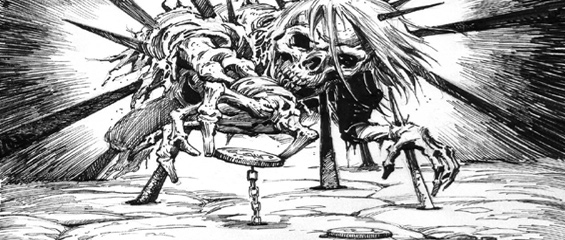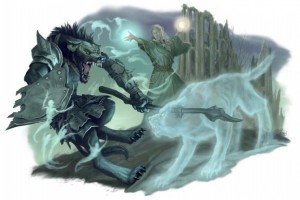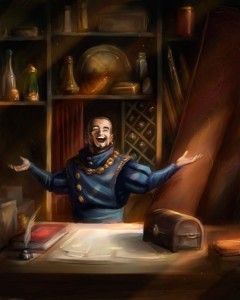
Video Game Analogies, Because I’m Dumb
 Yesterday a comparison came up regarding old game design ideals and the evolution of these things in general. My immediate thoughts was that if ‘new’ design consists of things like hour long hand-holding tutorials we see in modern video games? Is it when a game is so damn easy the whole thing feels like a tutorial? If that’s the case then I want no part in it. However if it’s something else entirely, then I’m all for keeping an open mind.
Yesterday a comparison came up regarding old game design ideals and the evolution of these things in general. My immediate thoughts was that if ‘new’ design consists of things like hour long hand-holding tutorials we see in modern video games? Is it when a game is so damn easy the whole thing feels like a tutorial? If that’s the case then I want no part in it. However if it’s something else entirely, then I’m all for keeping an open mind.
Is ‘new’ design having to fail 3 death saving throws along with 5 other constraints for a PC to actually die? I’m not truly a fan of all of these safeguards but if that’s what floats your boat, be my guest! Upon my snarkification of the subject Kato from One Inch Square gave a few great examples of “bad” design elements: high scores, extra lives, and running out of continues. The problem with this was is that my response was “Yeah? I love those games!” I think elements that give finality and the hint that complete and utter failure can be just around the corner are ones far too removed from many gaming mediums these days, I’d like to see them make a comeback.
The Illusion of Change
 Despite the good analogy I found that even those elements have their modern day translations and exist just beyond the veil of semantics. High scores are “leaderboards” and things like stat tracking of kill:death ratios or whatever other means of pissing match fodder game creators inject into their games. Surely “achievements” are just as if not more meaningless than a high score board, especially when you consider that acquiring a good portion of them are done so by completely arbitrary means. “Congrats, 25 achievement points! You beat all of level 3 in your underpants, on a Wednesday, with a pelican on your head!” Extra lives and continues still exist when the game rarely puts you in a position that a checkpoint or ducking behind cover for 10 seconds wont fix. I think things like this still exist no matter what kind of pretty face we paint on them. Of course they don’t exist verbatim so much, but they still lie within the lines without a doubt.
Despite the good analogy I found that even those elements have their modern day translations and exist just beyond the veil of semantics. High scores are “leaderboards” and things like stat tracking of kill:death ratios or whatever other means of pissing match fodder game creators inject into their games. Surely “achievements” are just as if not more meaningless than a high score board, especially when you consider that acquiring a good portion of them are done so by completely arbitrary means. “Congrats, 25 achievement points! You beat all of level 3 in your underpants, on a Wednesday, with a pelican on your head!” Extra lives and continues still exist when the game rarely puts you in a position that a checkpoint or ducking behind cover for 10 seconds wont fix. I think things like this still exist no matter what kind of pretty face we paint on them. Of course they don’t exist verbatim so much, but they still lie within the lines without a doubt.
Which brings us to: what is “good” design? The sentiments that surround these ideals are in a constant shift, and I’m not talking about out there in armchair-design blogger land. I’m talking about internally at places like WotC, or even big shot video game devs like Valve or Blizzard. We are constantly producting, evaluating, adjusting, and re-producing games and the ideals that comprise them. It is only natural of gaming and game design, yet there is something more granular here I’d like to touch on.
The Good, The Bad, The…Good?
Let’s take the monster manuals or essentials as an example here, comparing the early days of 4e to these books later released we see some themes: mathematical changes, layout facelifts, mechanics become more slightly muted while narration gains precedence, and the gernal streamlining, aggregation, and truncation game elements. Obviously these things were all a product of feedback, refinement, and emotional investment that both we as consumers and the devleopers themselves have in the game. These were largely regarded as improvements to the game (essentials is debatable by many, but let’s not go there now).
Now let’s take some elements of “bad” design and discuss them. Hmm let’s not beat around the bush and use …Fourthcore as an example here. It’s dungeon-centric, extremely niche, unforgiving, unfair, and both accepts and encourages metagame knowledge as part of the play experience. By many far and wide this is all a giant bundle of ‘terrible’! But why was something so terrible an ENnie nominated publication alongside Paizo products and other big names? Why did WotC attempt to begin catering to this niche with Lair Assault? Was it really all bad? Does the status quo or do talking heads of D&D have too much influence over what people feel is acceptible fun for their games? I think so.
What I’m saying here is obvious, if you find something fun in your game just take it and run with it. You don’t need the approval of anyone, anywhere, aside from your gaming group of course. What defines game design as good or bad is wholly determined by how we perceive it, and how much weight we add to the words of others. What is generally accepted as “good” today may be seen inversely tomorrow. Do what you like, and in all manner of discussions of game mechanics remain open minded to the fact that gaming groups other than yours do exist, and they may very well love what you hate and hate what you love. Just move along, different strokes and all that.
It’s Your Game, It Always Has Been

What I’m getting at here is that regardless of wether you deem save or die as “bad” design, it’s still design. As long as a game element is created with a facet of the player base in mind it is not bad design. It is simply design. If you feel it’s bad, or doesn’t work for you or your group then by all means don’t use it. There’s already enough things out there to fragment our fragile little community, bickering over whether step and die is superior or inferior to a climactic spotlighted moment death throws is neither here nor there.
For the record I am for save or die. I don’t think every character is a special flower. Life is fragile on all accounts and adventuring is deadly business. Every PC can’t make it out alive to become fucking bard songs. But none of this means that I’m going to verbally fight any of you to the death about why you should like it or includ it in your game or not.
Like a lot of other game elements and modularity we’re constantly talking about when it comes to D&DNext, this is all of course optional. There has been much debate over whether it will be “core” or not, and to that I say who gives a shit? If something is defined as core in a modular system, you can just unplug that core and fill it with whatever you want. How is option A any more or less significant than option B? Is it because option A is presented first so it’s assumed to carry more importance than the others? Are they not simply both…options?
I can’t even fathom why people get so worked up about this stuff. However even if this is not the case and some how “save or die” is embedded into every fiber of the game and zero alternative options are presented, I think we’ll allmake do won’t we? I trust all of you, each and every last one of you to be smart enough to devise something that works for your group. I may not have faith in the D&D community when it comes to alot of things but there is a small handful of a few things I can be sure of, and in this case it’s creativity.

Good stuff. I agree that the discussion can often seem very knee-jerk and emotional. But, Save or Die is a big deal for players because it often triggers frustrating memories for players. Time is limited, and for many the game should be fun. Death can be fun, but it can also be limiting and unfair. For example, in organized play prior to Living Forgotten Realms (LFR), death meant a lot of things:
– The end of being able to play that character, with all of the role-playing angles, ties to the setting, ties to other PCs, etc.
– The end of your ties to the ongoing narrative. Your goals, your hopes, your accomplishments all came to an end.
– The likely end of that class/race/etc. combination. While you can make another dwarven ranger, it won’t likely be as good as the last time. That means you likely need to now play something other than a dwarven ranger.
– In Living Greyhawk (LG) specifically, you were probably now at a lower level than your friends. Your backup PC might not be able to play with your friends, which means you really take a social cost on top of everything else.
– The death could be glorious, but it could also be from a bad/unfair judge.
So, in LFR we saw that practically all death was removed. You came back, and you didn’t even lose anything other than gold and a slight penalty to some rolls for part of the next adventure. Lame? Maybe. I’m not sure.
In theory, the other side of the coin is better enjoyment because we know life matters. Victory is more sweet when you know you can die. I think this is true to some extent, but the more I play the more I don’t think it has such an impact outside of the really major events (battle interactives, for example). That’s why in Ashes of Athas organized play we use a Death Certificate. When you die, you die… except that each adventure comes with a unique Death Certificate that gives you something. In the past PCs have negotiated with aarakocra. If a PC died in that mod, they came back as a bird-man. Each cert has an accompanying story, explaining how and why your PC comes back and any special benefits. This gives you the agony of defeat, and it makes survival perhaps a bit more thrilling, but it also softens the blow while continuing the narrative.
The narrative is my main issue with Save or Die. I’ve had countless PCs I cared about die in home campaigns. Many times those deaths were pretty lame. Poison spider in the moathouse? That was lame. I had spent so many hours working on that half-orc assassin herbologist’s past, goals, and RP! When the PC died, all that I had learned, all that I had done, all the relationships with Hommlet residents… all done. Bringing another PC into the campaign and having to meet those same NPCs and PCs again… it was a loss of narrative.
And to some (though not to me) dying is failure. Life can be hard enough that you want your diversion to be less depressing and more victorious. I can understand that. So, while I’m ok with Save or Die, I would rather see other alternatives. And I do think it is an ok debate topic. It deals with what a player can take for granted, with the investment and the returns.
One last thing. You said above that “Why did WotC attempt to begin catering to this niche with Lair Assault?” Lair Assault was conceived by WotC before Fourthcore ever came out. The concept was really to cater to players that felt they weren’t being challenged enough by LFR, and to provide a quick fun gaming session without needing to be an ongoing investment of time. The program was refined over a long time, but those aspects are still true. I don’t think it has ever really been Fourthcore or even heavily influenced by Fourthcore. Fourthcore to me has very different elements (classic adventure elements, more arbitrary impacts, more puzzles, more problem solving, etc.). I wouldn’t be surprised if WotC saw in Fourthcore validation for the LA program, but I don’t think it was ever a deliberate emulation. I’m not even sure they attract the same players, to be honest.
Wizards admits D&D Encounters has been more successful and lasted longer than they expected. Lair Assault came along way after Encounters started. I don’t think Wizards would have even given LA a thought if Encounters had only lasted the 3 season run they initially planned. Fourthcore was already established when Encounters launched. As an outside observer, it seemed obvious to me that LA was Wizards take on the Fourthcore design paradigm, or was at least influenced in part by the attention Fourthcore was getting from the community.
Chris, I didn’t mention Encounters (I did mention LFR, however, which began with 4E at the very beginning). Lair Assault was discussed on the LFR forums as far back as 2009, which should be before Fourthcore had been released. Two things being similar does not make them causal.
I am curious about your saying that Encounters lasted longer than they expected. Could you provide a source for that? (It is possible, just not anything I recall). Thanks!
Alpha.. I remember it being discussed in one of the wotc podcasts. I think it was from last year’s GenCon from the session on organized play. The speaker talked about how they only planned about 3 seasons of Encounters but the popularity of the program was greater than expected and they had to come up with additional seasons and this is when they started to do the product tie-ins.
Well in any case, I’m happy Fourthcore and LA assault pushed the paradigm of encounters being unfair and deadly.
increased lethality is a good thing imo. of course, when i sarted playing we died so much we spent more time rolling pcs than playing it seems like. it is nice in b/x to have a new pc rolled in like 5 mins, not so nice with 4e. i have seen very few deaths in 4e, mostly from my own campaigns and fourthcore games, although there was a tpk in the first encounters season that still haunts my dreams. it looks like 5e steps up the danger considerably and that is definitely a plus in my book. running should sometimes be the best option; one of my 4e players (beginner) said to me and i shit you not: “we can run?”
I feel the need to write a follow up articles here about the good and bad of save or die, but since I’m lazy – and a bunch of people spent a lot of time bickering I’ll just leave this post with you guys to pick the good bits from.
Stuart Robinson in particular has some really great examples of the good and the bad of SoD in the discussion. Check it out here: https://plus.google.com/115803692445846987560/posts/XoMr7oseYvQ
Good points, Frothsof. I find that in any edition my players (whether home campaign or in organized play) won’t run the first time. It takes at least one clear-cut case of “yes, encounters really can be too hard and you will have to run” to drive home the message. I have been pleased to see that in Ashes of Athas players have responded to that. Veteran players are now approaching situations that look dangerous with more caution, realizing that it could be necessary to run or to defeat the encounter in an unusual way. That’s something that I think Fourthcore has helped with – showcasing examples where the only way to win is something you have to figure out.
I thought a really big mistake made with 4E was in having those early DMG traps be so ignorable. You were legitimately better off leaving a trap until combat (with the monsters) was done, then disarming it. That’s a shame, because traps should be an excellent source of pressure. It should be that moment where you curse and ask your rogue to bravely handle the trap while the rest of the team holds off the enemies. Over time traps improved, but they still are too much like “another monster” and less like a unique overlay of danger on the encounter (often achieved instead through terrain).